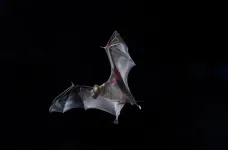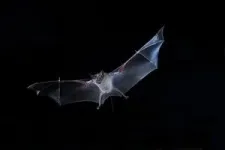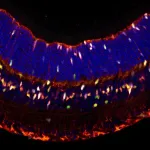(Press-News.org) Aya Goldshtein, Omer Mazar, and Yossi Yovel have spent many evenings standing outside bat caves. Even so, seeing thousands of bats erupting out of a cave and flapping into the night, sometimes in densities so high that they appear liquid, astounds the scientists every time. But until recently, the bat biologists were even more baffled by what they didn’t see. “The bats don’t run into each other,” says Goldshtein from the Max Planck Institute of Animal Behavior, “even in colonies of hundreds of thousands of bats all flying out of a small opening.”
A “nightmare” cocktail party
How bats don’t fatally crash into each other every night when they squeeze out of caves to forage was a scientific mystery. Many bats perceive their world mostly through echolocation: they emit a call and listen for the reflected echo, which in turn allows them to “see” what is around them. But if many bats are echolocating at once—such as when a whole colony emerges from a cave in the space of a few minutes—then the calls of others should drown out the important echoic information that bats need. Scientists call this loss of acoustic information “jamming” and they expect that bats should collide because of it.
And yet, aerial accidents outside caves are so rare, “you’re almost excited when you witness one,” says Goldshtein.
For decades, scientists have tried to figure out how bats solve this “cocktail party nightmare” in which ambient chatter deafens you to the voice you need to hear. For example, they examined how bats echolocate in groups. In the laboratory, scientists observed that individual bats in a small group each echolocated at a slightly different frequency, which in theory should reduce jamming. Was this the solution?
Yovel says that past studies like these are important stepping stones, but they have fallen short of providing a compelling answer to the cocktail party mystery because of a crucial missing piece. “No one had looked at this situation from the point of view of an individual bat during emergence. How can we understand a behavior if we don’t study it in action?”
Stepping into the bat cave
For the first time, Goldshtein and colleagues have collected data from wild bats emerging from a cave at dusk. They used a combination of high-resolution tracking, developed by Ran Nathan and Sivan Toledo, ultrasonic recording, and sensorimotor computer modeling—all of which allowed the researchers to step into the bats’ sensory world as the animals squeezed out of the cave opening and flew through the landscape to forage.
The team, which was led by scientists from Tel Aviv University, studied greater mouse-tailed bats in Israel’s Hula Valley. Over two years, they tagged tens of bats with lightweight trackers that recorded the bats’ location every second. Some of these tags also included ultrasonic microphones that recorded the auditory scene from the individual bat’s point of view. Each year, data was collected on the same night that bats were tagged.
A caveat: the tagged bats were released outside the cave and into the emerging colony, meaning that real data were missing at the cave opening when density is highest. The team filled in this gap with a computational model that was developed by Omer Mazar and simulated emergence. The model incorporated data collected by the trackers and microphones to recreate the full behavioral sequence starting from the entrance of the cave and ending after bats had flown two kilometers through the valley. “The simulation allows us to verify our assumptions of how bats solve this complex task during emergence,” says Mazar.
Sidestepping a sonic dilema
And the picture that emerged was remarkable. When exiting the cave, bats experience a cacophony of calls, with 94 percent of echolocations being jammed. Yet, within five seconds of leaving the cave, bats significantly reduced the echolocation jamming. They also made two important behavioral changes: first, they fanned out from the dense colony core while maintaining the group structure; and second, they emitted shorter and weaker calls at higher frequency.
The researchers suspected that bats would reduce jamming by quickly dispersing from the cave. But why did bats change their echolocation to a higher frequency? Wouldn’t more calling only increase the problem of jamming and therefore collision risk? To understand that result, the authors had to approach the scene from a bat’s point of view.
Says Mazar: “Imagine you’re a bat flying through a cluttered space. The most important object you need to know about is the bat directly in front. So you should echolocate in such a way that gives you the most detailed information about only that bat. Sure, you might miss most of the information available because of jamming, but it doesn’t matter because you only need enough detail to avoid crashing into that bat.”
In other words, bats change the way they echolocate to gain detailed information about their near neighbors—a strategy that ultimately helps them to successfully maneuver and avoid collisions.
The authors emphasize that this unexpected result for how bats solve the cocktail party dilemma was made possible by studying bats in their natural environment as they perform the relevant task. “Theoretical and lab studies of the past have allowed us to imagine the possibilities,” says Goldshtein. “But only by putting ourselves, as close as possible, into the shoes of an animal will we ever be able to understand the challenges they face and what they do to solve them.”
END
Scientists solve “cocktail party” mystery of bat echolocation
When emerging at night by the thousands, bats avoid colliding by changing how they move and echolocate
2025-03-31
ELSE PRESS RELEASES FROM THIS DATE:
USC Stem Cell mouse study identifies shared genes involved in hearing and vision regeneration
2025-03-31
The same genes could hold the key to regenerating cells in the ear and eye, according to a new mouse study from the USC Stem Cell laboratory of Ksenia Gnedeva, PhD, published in the Proceedings of the National Academy of Sciences (PNAS).
“The proliferation of progenitor cells in response to injury is a crucial step in the regeneration of sensory receptors, but this process is blocked in the mammalian inner ear and retina. By understanding the genes that enforce this block, we can advance efforts to restore hearing and vision in patients,” said Gnedeva, an assistant professor in the USC Tina and Rick Caruso Department of Otolaryngology ...
New study challenges the story of humanity’s shift from prehistoric hunting to farming
2025-03-31
A new study published in Proceedings of the National Academy of Sciences (PNAS) has turned traditional thinking on its head by highlighting the role of human interactions during the shift from hunting and gathering to farming - one of the biggest changes in human history - rather than earlier ideas that focused on environmental factors.
The transition from a hunter-gatherer foraging lifestyle, which humanity had followed for hundreds of thousands of years, to a settled farming one about 12,000 years ago has been widely discussed in popular books like Sapiens: A Brief History of Humankind by Yuval Noah Harari.
Researchers from the University of Bath, the Max Planck Institute ...
Oldest known phosphatic stromatoporoid sponge discovered in south China
2025-03-31
International scientists have uncovered the oldest known phosphatic stromatoporoid sponge, dating back approximately 480 million years to the Early Ordovician, in South China.
Stromatoporoid sponges were key reef builders during the Palaeozoic era, playing a crucial role in constructing biological frameworks—similar to the role of modern corals. They were especially important during the middle Paleozoic era (from the late Middle Ordovician to Devonian), a time marked by a major transition from microbial-dominated to skeletal-dominated reef ecosystems. Previously, stromatoporoid ...
Brian Brown, Ph.D., inducted into AIMBE College of Fellows for pioneering contributions in gene therapy and functional genomics
2025-03-31
New York, NY [March 31, 2025] — Brian Brown, PhD, Director of the Icahn Genomics Institute at the Icahn School of Medicine at Mount Sinai, has been elected to the College of Fellows of the American Institute for Medical and Biological Engineering (AIMBE). He was honored for his seminal work in gene therapy and functional genomics, which has helped transform the fields and contributed to key advancements in medicine and biotechnology.
Election to the AIMBE College of Fellows is one of the highest professional distinctions in the field. It recognizes the ...
My robot therapist: The ethics of AI mental health chatbots for kids
2025-03-31
Mental health care can be difficult to access in the U.S. Insurance coverage is spotty and there aren’t enough mental health professionals to cover the nation’s need, leading to long waits and costly care.
Enter artificial intelligence (AI).
AI mental health apps, ranging from mood trackers to chatbots that mimic human therapists, are proliferating on the market. While they may offer a cheap and accessible way to fill the gaps in our system, there are ethical concerns about overreliance on ...
Rice scientists pioneer method to tackle ‘forever chemicals’
2025-03-31
Rice University researchers have developed an innovative solution to a pressing environmental challenge: removing and destroying per- and polyfluoroalkyl substances (PFAS), commonly called “forever chemicals.” A study led byJames Tour, the T.T. and W.F. Chao Professor of Chemistry and professor of materials science and nanoengineering, and graduate student Phelecia Scotland unveils a method that not only eliminates PFAS from water systems but also transforms waste into high-value graphene, offering a cost-effective and sustainable approach to environmental remediation. This research was published March 31 in Nature Water.
PFAS ...
Exploring why some athletes perform better than others under stress
2025-03-31
Lack of sleep and stress hinder athletic performance, but some athletes may be better at performing competitively despite sleep issues and stress. In a new JNeurosci paper, researchers led by Yan Sun, from Peking University, looked for predictive behavioral and neural markers in athletes who maintain their performance level following sleep deprivation and under stress.
The researchers assessed college and professional athletes’ stress levels and cognitive changes after 24 h of sleep deprivation, then followed their ...
Exploring binge eating and binge drinking alcohol comorbidity
2025-03-31
The comorbidity of binge eating and alcohol binge drinking is prevalent and increases the risk of other neuropsychiatric and bodily conditions. However, the mechanisms linking these forms of binge consumption are unclear. To explore the link between binge eating and binge drinking alcohol, Karen Szumlinski, from the University of California, Santa Barbara, and colleagues developed a way to model the disease comorbidity in mice. As reported in their JNeurosci paper, this mouse model led to the discovery that females with a history of binge eating start binge drinking ...
The proportion of harmful substances in particulate matter is much higher than assumed
2025-03-31
People breathing contaminated air over the course of years are at greater risk of developing numerous diseases. This is thought to be due to highly reactive components in particulate matter, which affect biological processes in the body. However, researchers from the University of Basel, Switzerland, have now shown that precisely these components disappear within hours and that previous measurements therefore completely underestimate the quantities in which they are present.
From chronic respiratory problems to cardiovascular diseases, ...
Administration is weakening U.S. research capacity and endangering Americans, nation’s leading scientists warn
2025-03-31
The wellbeing of Americans and the country’s longstanding position as a world leader in science and technology are in jeopardy due to the actions of the Trump administration, approximately 1,900 leading figures in medicine, science, and engineering warn today in an open statement to the American public. The list of signatories includes Nobel Prize winners, deans of medical schools, and national leaders in science and technology.
“For over 80 years, wise investments by the US government have built up the nation’s research enterprise, making it the envy of ...
LAST 30 PRESS RELEASES:
IADR elects George Belibasakis as vice-president
Expanding the search for quantum-ready 2D materials
White paper on leadership opportunities for AI to increase employee value released by University of Phoenix College of Doctoral Studies
ASH 2025: New combination approach aims to make CAR T more durable in lymphoma
‘Ready-made’ T-cell gene therapy tackles ‘incurable’ T-cell leukemia
How brain activity changes throughout the day
Australian scientists reveal new genetic risk for severe macular degeneration
GLP-1 receptor agonists likely have little or no effect on obesity-related cancer risk
Precision immunotherapy to improve sepsis outcomes
Insilico Medicine unveils winter edition of Pharma.AI, accelerating the path to pharmaceutical superintelligence
Study finds most people trust doctors more than AI but see its potential for cancer diagnosis
School reopening during COVID-19 pandemic associated with improvement in children’s mental health
Research alert: Old molecules show promise for fighting resistant strains of COVID-19 virus
Journal of Nuclear Medicine Technology supplement highlights advances in theranostics and opportunities for growth
New paper rocks earthquake science with a clever computational trick
ASH 2025: Milder chemo works for rare, aggressive lymphoma
Olfaction written in bones: New insights into the evolution of the sense of smell in mammals
Engineering simulations rewrite the timeline of the evolution of hearing in mammals
New research links health impacts related to 'forever chemicals' to billions in economic losses
Unified EEG imaging improves mapping for epilepsy surgery
$80 million in donations propels UCI MIND toward world-class center focused on dementia
Illinois research uncovers harvest and nutrient strategies to boost bioenergy profits
How did Bronze Age plague spread? A sheep might solve the mystery
Mental health professionals urged to do their own evaluations of AI-based tools
Insufficient sleep associated with decreased life expectancy
Intellicule receives NIH grant to develop biomolecular modeling software
Mount Sinai study finds childhood leukemia aggressiveness depends on timing of genetic mutation
RSS Research Award for new lidar technology for cloud research
Novel AI technique able to distinguish between progressive brain tumours and radiation necrosis, York University study finds
Why are abstinent smokers more sensitive to pain?
[Press-News.org] Scientists solve “cocktail party” mystery of bat echolocationWhen emerging at night by the thousands, bats avoid colliding by changing how they move and echolocate



